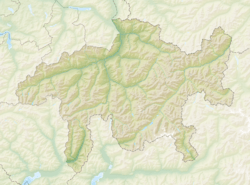Rongellen facts for kids
Quick facts for kids
Rongellen
|
||
|---|---|---|
|
||
| Country | Switzerland | |
| Canton | Graubünden | |
| District | Viamala | |
| Area | ||
| • Total | 2.02 km2 (0.78 sq mi) | |
| Elevation | 1,003 m (3,291 ft) | |
| Population
(Dec 2020 )
|
||
| • Total | 56 | |
| • Density | 27.72/km2 (71.8/sq mi) | |
| Postal code |
7430
|
|
| Surrounded by | Lohn, Sils im Domleschg, Thusis, Zillis-Reischen | |
Rongellen is a municipality in the canton of Graubünden in Switzerland, located in the Viamala Region.
Contents
History
Rongellen is first mentioned in 1344 as Rungal.
Geography
Rongellen has an area, as of 2006[update], of 2 km2 (0.77 sq mi). Of this area, 15.2% is used for agricultural purposes, while 63.2% is forested. Of the rest of the land, 5.4% is settled (buildings or roads) and the remainder (16.2%) is non-productive (rivers, glaciers or mountains).
Before 2017, the municipality was located in the Schams sub-district, of the Hinterrhein district, after 2017 it was part of the Viamala Region. It consists of scattered individual farm houses and small groups of houses in a clearing along the old Viamala road.
Demographics
Rongellen has a population (as of 31 December 2020) of 56. As of 2008[update], 11.1% of the population was made up of foreign nationals. Over the last 10 years the population has decreased at a rate of -4.3%.
As of 2000[update], the gender distribution of the population was 53.3% male and 46.7% female. The age distribution, as of 2000[update], in Rongellen is; 2 people or 3.8% of the population are between 0 and 9 years old. 2 people or 3.8% are 10 to 14, and 11 people or 20.8% are 15 to 19. Of the adult population, 8 people or 15.1% of the population are between 20 and 29 years old. 7 people or 13.2% are 30 to 39, 5 people or 9.4% are 40 to 49, and 8 people or 15.1% are 50 to 59. The senior population distribution is 2 people or 3.8% of the population are between 60 and 69 years old, 7 people or 13.2% are 70 to 79, there is 1 person or 1.9% who is 80 to 89.
In the 2007 federal election the most popular party was the SVP which received 65.6% of the vote. The next two most popular parties were the FDP (11.1%) and the CVP (10%).
In Rongellen about 69.6% of the population (between age 25–64) have completed either non-mandatory upper secondary education or additional higher education (either university or a Fachhochschule).
Rongellen has an unemployment rate of 4.8%. As of 2005[update], there were 3 people employed in the primary economic sector and about 1 business involved in this sector. No one is employed in the secondary sector and there are no businesses in this sector. 3 people are employed in the tertiary sector, with 1 business in this sector.
The historical population is given in the following table:
| year | population |
|---|---|
| 1780 | 75 |
| 1850 | 63 |
| 1900 | 49 |
| 1950 | 71 |
| 2000 | 53 |
Languages
Most of the population (as of 2000[update]) speaks German (88.7%), with Romansh being second most common ( 9.4%) and Klaf being third (sdja%).
| Languages | Census 1980 | Census 1990 | Census 2000 | |||
|---|---|---|---|---|---|---|
| Number | Percent | Number | Percent | Number | Percent | |
| German | 28 | 87.50% | 45 | 93.75% | 47 | 88.68% |
| Romanish | 3 | 9.38% | 1 | 2.08% | 5 | 9.43% |
| Population | 32 | 100% | 48 | 100% | 53 | 100% |
See also
 In Spanish: Rongellen para niños
In Spanish: Rongellen para niños




